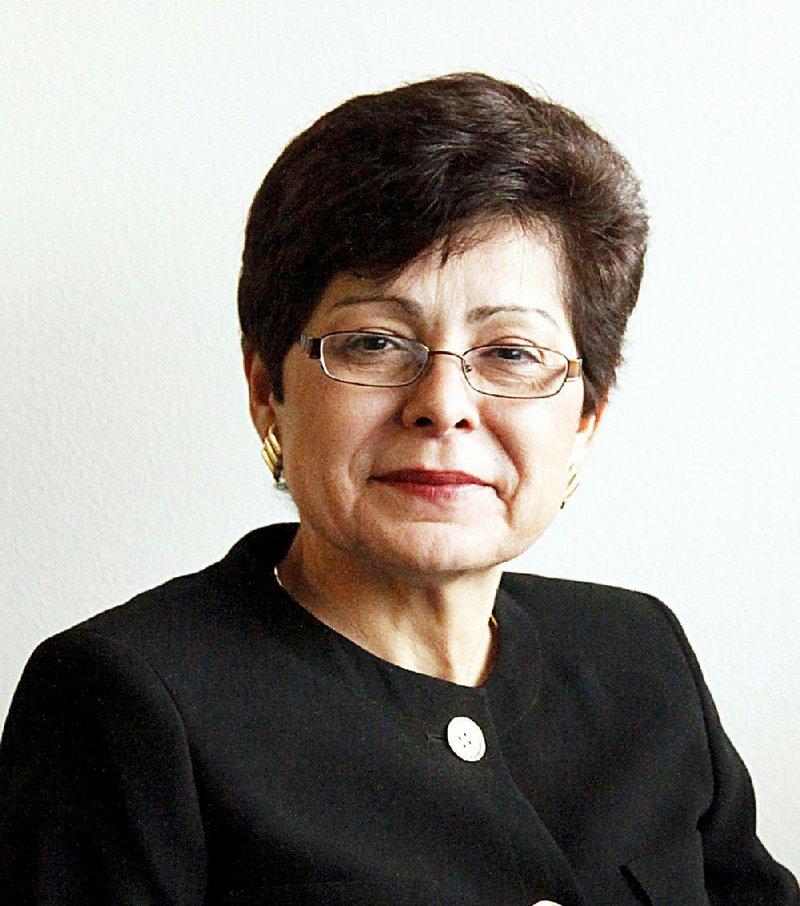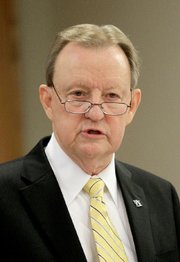The University of Arkansas at Little Rock is planning to make $2.4 million in cuts to its five colleges and nonacademic units.
The cuts -- most of which are to take effect July 1 -- are part of a restructuring that the university started in 2013. Coupled with the restructuring, the university has seen drops in student enrollment and, as a result, drops in revenue from tuition and fees, prompting officials to look for more savings.
"We are faced with significant challenges -- declining state support, soft enrollment, competition with other institutions, and a lingering economic slowdown," a task force said in a 2013 report to Provost Zulma Toro. "Business as usual is no longer sufficient."
And students face some uncertainty. They will see larger class sizes in some academic areas, and some programs they pursue may be streamlined. But they will also have more courses offered online, and those courses may better fit their schedules. The provost and chancellor have worked to mitigate the effect on students.
For faculty members, the uncertainty is starting to settle down. Interim or vacant leadership positions are slowly being filled, and there is a plan for the university moving forward. But administrators will continue monitoring some programs to see if enrollment justifies keeping them.
The university's slow decline in enrollment began after the fall 2010 semester, when it had a record high of 13,176 students. Each fall since, the number has slipped. UALR had 11,645 students in the fall of 2014, according to data from the state Department of Higher Education.
The loss of students has led to a $3.2 million reduction in tuition revenue in the fiscal year ending June 30, 2014, university officials have said. So far this fiscal year, the university has lost $3.1 million in tuition revenue.
Those losses prompted university administrators to call for budget cuts, hiring freezes and the review of collaborations within the metropolitan school and outside it.
"That has overlaid the whole restructuring process with issues of budget restrictions," Chancellor Joel E. Anderson said in a recent interview. "That's what has really intensified and made the restructuring process more complicated. The decline in enrollment and particularly the significant revenue loss from this last tuition and fee income was not anticipated, and so that's not been easy for people to deal with."
The problem isn't unique to UALR. Nationwide, small universities and liberal arts colleges have closed their doors, merged with other institutions or ramped up their marketing strategies.
In Arkansas, nearly half of the public universities are following that enrollment trend.
UALR's largest overall feeder school, Pulaski Technical College, saw a nearly 23 percent decrease in enrollment over a four-year period. The college had 11,946 students in the fall of 2011. That number dropped to 9,236 in the fall of 2014.
State officials have said the enrollment slowdown is tied to an improving economy. The more jobs that are available, the less people turn to higher-education institutions.
But college and university officials point to other things, too.
In 2011, the federal financial-aid requirements grew stricter alongside a $5.7 billion blow to the Pell Grants program, which provides money for college that low-income undergraduates do not have to pay back. Besides the Pell Grants program cuts, the Arkansas Academic Challenge scholarship program has tightened eligibility standards after lottery proceeds -- which fund the scholarships -- have decreased through the years.
Almost two-thirds of all UALR students receive some type of financial assistance to attend school, while nearly a third get aid from the federal Pell Grants program.
Also, college admission standards have become more stringent as the brick-and-mortar schools face more competition from online programs in and out of state, some officials said.
At UALR, officials first began reviewing the university's administrative structure, cutting the number of vice chancellors from seven to four and reconfiguring the academic colleges.
They reduced all nonpersonnel accounts -- such as maintenance -- by 10 percent.
They implemented early retirement incentives, but later did away with the program for tenured faculty members.
They instituted a "semi-hard" hiring freeze, leaving unfilled positions vacant.
Now, they're looking at the academic programs and nonacademic units.
Anderson has approved Toro's recommendations for the academic programs. For nonacademic units, Anderson has given the go-ahead for "dollar figure levels," but he said he wants to meet with representatives from each unit to discuss how to proceed with cuts.
Among 22 general changes, Toro plans to implement a universitywide policy related to faculty workloads, to slash the lecturer budget by nearly half, to increase the number of students in courses, and to encourage administrators at the dean level and upward to teach at least one course per academic year.
The general changes "will keep on giving over time" in quality and cost controls, Anderson said in a memorandum to the faculty and staff.
"Reducing operating costs through such measures is far preferable to reducing costs by eliminating positions or programs," he said in the memo. "It is reduction of costs through toning and tightening up instead of surgery."
The workload policy and the cuts in the lecturer budget were what initially caught the attention of the faculty, faculty senate President Andrew Wright said.
Faculty members had been concerned that implementing a 1994 load policy -- which would require full-time faculty members to teach four three-hour sections, while department chairmen and school directors teach two sections -- would not allow for research or public service. A professor could spend the time preparing for one course on other equivalent work, such as writing grant proposals, in a laboratory or helping graduate students with dissertations, Wright said.
The provost updated her initial recommendation, saying most of the colleges already have policies to allow for other scholarly activities. A task force, made up of faculty members, is working to review all policies on workloads and will submit a report to Toro when it's completed.
The university is cutting its lecturer budget by 46 percent, or $705,563, per fiscal year.
"There are places where you have to use lecturers," Wright said. "For instance, you're approaching the academic year and one of your faculty members unexpectedly leaves. You aren't going to hire a new professor. The concern was that those kinds of things ultimately would be very damaging to the university if we did not have that flexibility."
Some lecturers -- mostly adjunct professors -- have professional experience and can teach courses in their field of expertise, he added. The university's planning and finance committee also said the budget reduction could affect graduate students, who are paid through lecturer funds to teach laboratory courses, and undergraduate enrollment and retention.
Toro updated her original proposal on using lecturers, saying officials will keep in mind any unique and specialized needs of departments and programs.
She also made college-specific budget reductions.
The College of Arts, Letters and Sciences was told to cut $50,000, which she said includes a vacant staff position and maintenance funds. That college will also phase out its environmental health program and, instead, form partnerships with the University of Arkansas for Medical Sciences and UALR's College of Engineering and Information Technology for initiatives in that field.
The Engineering and Information Technology College will slash $300,000 from its budget, the most of the university's five colleges. This college will retool the systems engineering program to meet the needs of local, regional and national industry; offer more online programs; and reduce the number of study tracks in the doctoral program.
The College of Business will combine finance and accounting graduate programs, and seek external funding for research databases that cost $50,000.
For the College of Education and Health Professions, Toro suggested creating a new school for the departments of counseling, adult and rehabilitation education, and of health, human performance and sport management. The college will reduce its budget by $125,000.
Of the five colleges, the College of Social Sciences and Communication is seeing the most reconfiguration. Here, the provost favored creating a new school within the college to house six different academic programs, including the master's of public administration, the bachelor's in international studies and a graduate certificate in conflict mediation. UALR will offer a new undergraduate major in urban planning and development, which will become part of the school.
A planning group will sort out the new school's faculty governance, tenure and promotion, and operational details.
Officials will also look for ways to strengthen the criminal justice undergraduate program, "reinvent" the academic programs within the School of Mass Communication and "rethink" the master's in public administration program.
"Unless the enrollment in the MPA [master's in public administration] program increases significantly for Fall 2016, the current size of the faculty is not justified," Toro said in her recommendations.
Amanda DiPippa, a budget analyst at the state Department of Finance and Administration, is nine hours short of earning her master's degree in public administration. DiPippa had been out of school for about a decade and decided to return for a master's degree after hearing good things about the public administration program.
Doing away with the program would be a "disadvantage" for UALR, DiPippa said.
"Little Rock is the center of state government," she said. "They have had classes that have aspects of community development and economic development. They deal with budgeting. Really, you can utilize those tools outside of private government. If they got rid of it, that would leave basically going to east Arkansas or UA-Fayetteville."
In his latest memo to faculty and staff members, Anderson said universities must "constantly focus and refocus" resources on viable programs that have potential.
"If our enrollment declines again this fall, we will likely have to confront the prospect of program eliminations," he said in the memo. "However, because of the difficult work we all have endeavored to complete over the past two years, we are well prepared to manage our financial challenges."
Metro on 05/11/2015

